Location-Based Virtual Reality Market Size
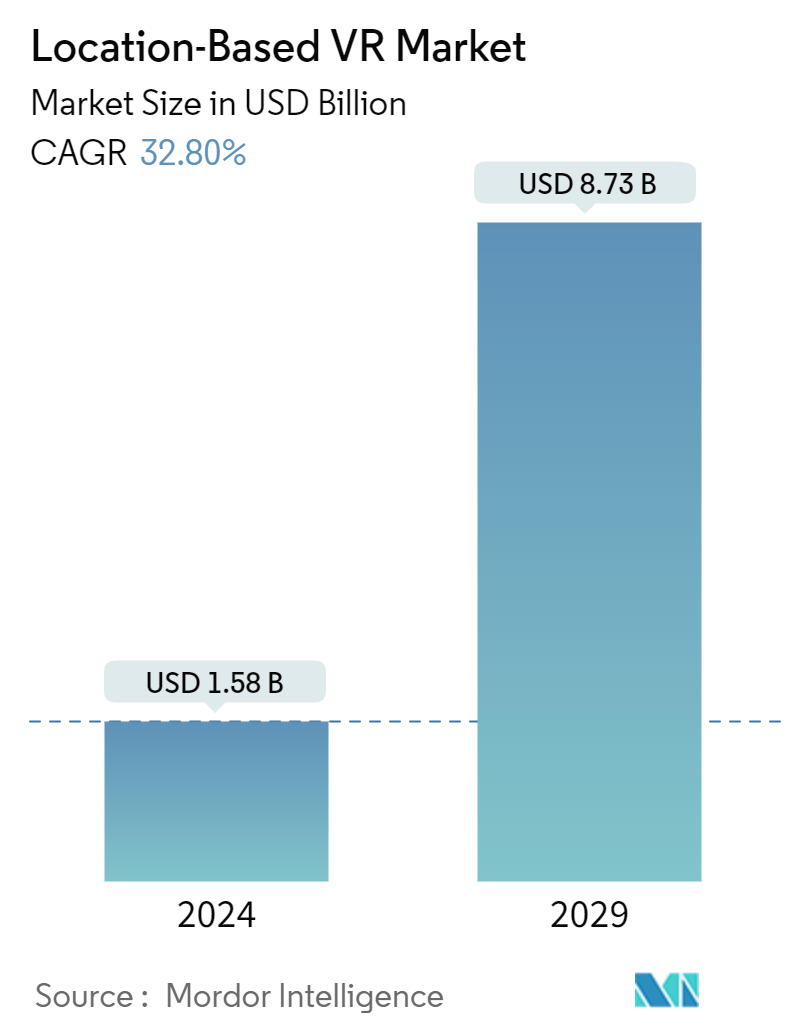
| Study Period | 2019 - 2029 |
| Market Size (2024) | USD 1.58 Billion |
| Market Size (2029) | USD 8.73 Billion |
| CAGR (2024 - 2029) | 32.80 % |
| Fastest Growing Market | Asia-Pacific |
| Largest Market | North America |
Major Players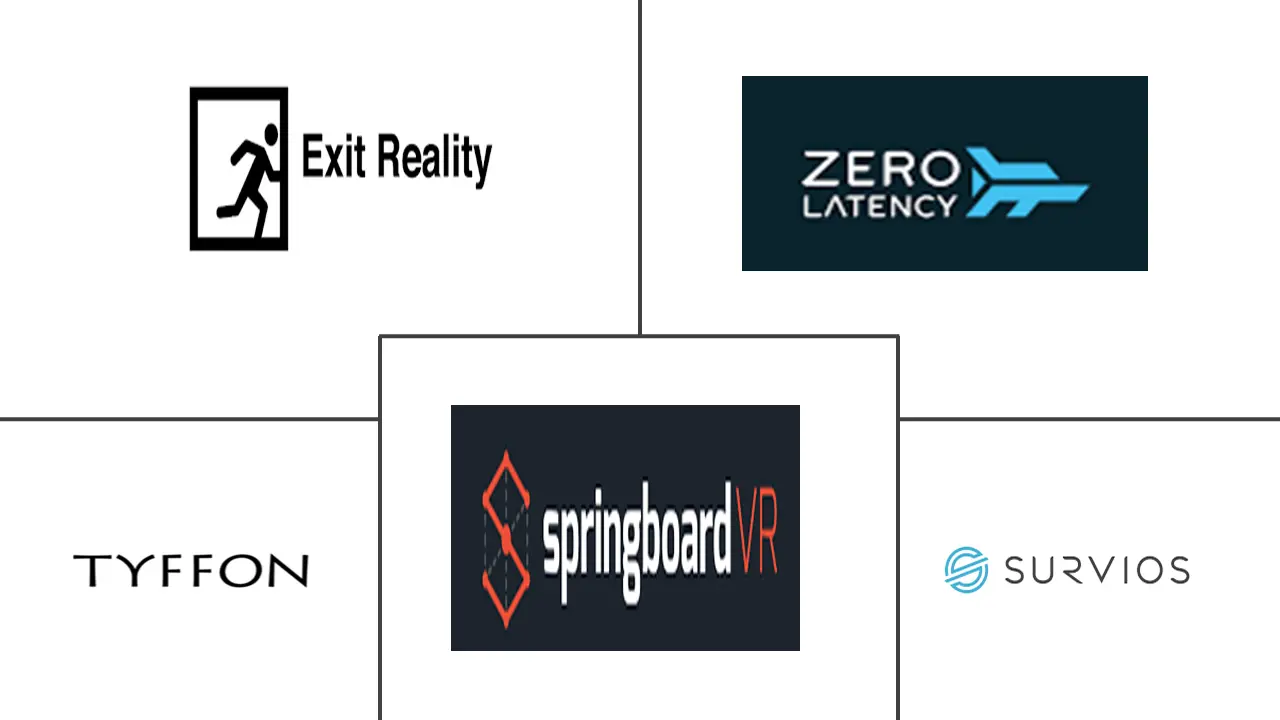
*Disclaimer: Major Players sorted in no particular order |
Need a report that reflects how COVID-19 has impacted this market and its growth?
Location-Based Virtual Reality Market Analysis
The Location-Based VR Market size is estimated at USD 1.58 billion in 2024, and is expected to reach USD 8.73 billion by 2029, growing at a CAGR of 32.80% during the forecast period (2024-2029).
- Virtual reality (VR) technology has evolved by leaps and bounds over the years, offering immersive experiences that transport users to a digital realm. A significant aspect of this evolution is the emergence of the location-based virtual reality (LBVR) market. LBVR takes VR experiences beyond the confines of homes and offices, allowing users to explore interactive virtual worlds in dedicated physical spaces. Location-based VR centers provide high-quality immersive VR experiences to consumers. These centers have advanced hardware motion-tracking systems and various interactive content, giving users an unparalleled and shared experience. The LBVR concept aims to create a social and communal environment for users to enjoy VR, fostering a unique experience.
- Since its inception, the LBVR market has witnessed remarkable growth, driven by a surge in demand for immersive experiences and advancements in VR technology. Players like The Void, Dreamscape Immersive, Zero Latency, and others have spearheaded this growth by creating innovations. For instance, in December 2023, Sandbox VR, a destination for location-based virtual reality experiences, announced a franchise deal with Next Level Erlebnisse, resulting in a significant European expansion. The companies would open ten new virtual reality locations across Germany, including Northrhine-Westphalia, Rhineland Palatinate, Saarland, and Hesse, showing the demand for future market growth.
- Location-based VR destinations have been combining the captivating storyline of Hollywood with the exhilarating thrill of theme park rides. Powered by full-body tracking technology, these heart-pumping dynamic adventures offer a significant level of immersion, engaging visitors in a visceral experience. The high-quality VR technology, such as improved headsets, motion controllers, and tracking systems, is critical in allowing users to interact with virtual surroundings more naturally and engagingly. The need for hardware becomes more apparent in location-based VR, where virtual features are superimposed on physical spaces. Therefore, constant developments in VR hardware are essential in attracting customers to embrace location-based VR, propelling market growth and driving innovation.
- The market for LBVR is still in a nascent stage. Making the VR experience more real is critical for market adoption and penetration. Increasing the implementation of VR technology, increasing investments in VR technology, and the growing popularity of 360-degree content are other significant factors influencing the growth of the LBVR market. High-quality content plays a crucial role in this industry. The market is expected to grow as more compelling, high-quality content that appeals to a wide demographic enters the market. However, the initial cost of investments in developing the location-based VR market could be a major hindrance to the market’s growth.
- The COVID-19 crisis impacted most VR tech companies. Several VR gaming centers were closed due to stay-at-home orders during the initial months of the pandemic. Supply-chain disruptions, store closures, and delayed enterprise implementations cast shadows on the short-term outlook in the recent year. However, remote working requirements, augmented meeting places, contactless business processes, and virtual social togetherness increased the demand for enabling VR technologies after the pandemic.
Location-Based Virtual Reality Market Trends
VR Arcades Contribute Significantly to Market Growth
- The emergence of virtual reality (VR) arcades has significantly impacted the gaming market by introducing a novel entertainment concept. These arcades offer immersive experiences that transport users to new worlds, fueling demand for location-based VR hardware and software.
- Advanced technologies such as 3D, 4D, 5D, and immersive VR content, particularly 360-degree videos, are driving the growth of the global gaming content market. VR arcades are increasingly adopting these technologies, creating a greater demand for camera systems capable of recording complete 360-degree views to provide users with fully immersive experiences.
- The expansion of VR arcades has made virtual reality gaming more accessible to the general public. Many individuals who may not have otherwise been able to afford or access VR technology can now enjoy these immersive experiences at their local arcade. This increased accessibility is expected to further fuel the growth of the VR arcade market.
- In April 2024, Ctrl V, a virtual reality arcade, announced plans to expand its presence across Canada and the United States. This expansion strategy indicates strong future demand for VR arcades.
- The pricing models in VR arcades, such as pay-per-play, are becoming increasingly economical. By charging customers based on the time they spend playing a particular game, these arcades allow users to experience VR without committing to a long-term membership. This flexibility is supporting the growth of VR arcades worldwide and driving demand for location-based VR technology.
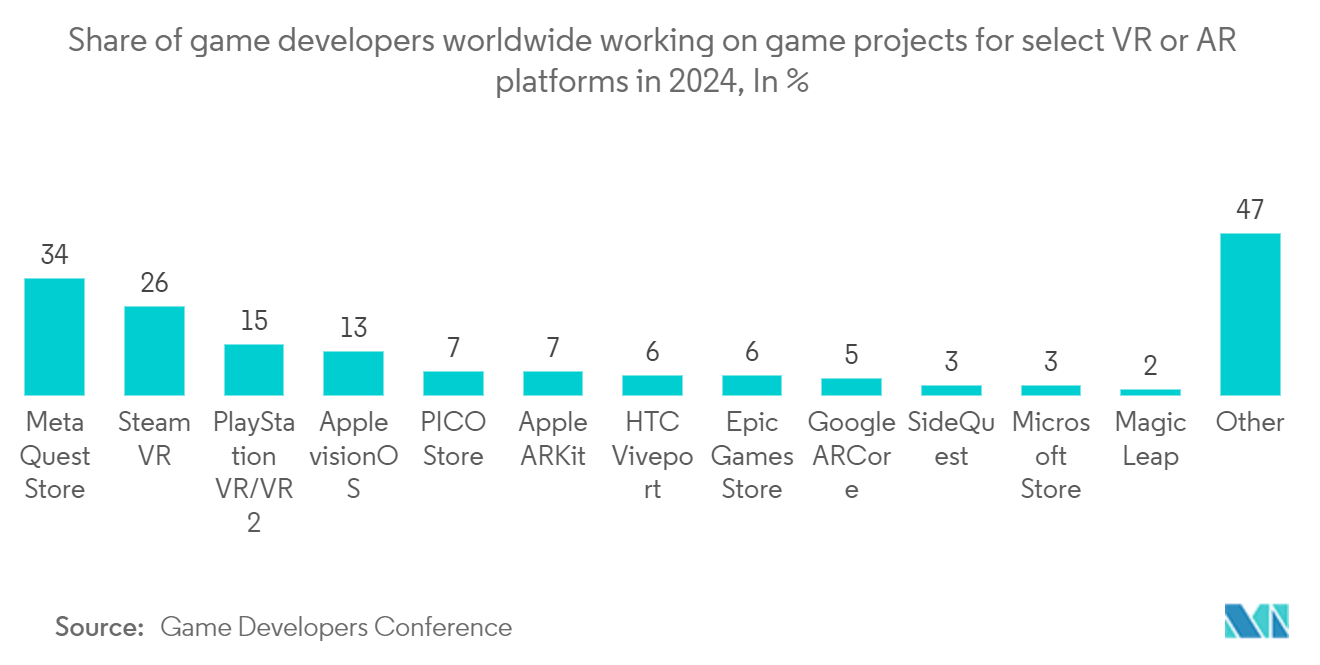
Asia-Pacific Expected to Witness Significant Growth
- The Asia-Pacific region is expected to hold a substantial share of the market studied due to its large and growing economies and increasing acceptance of VR devices. This favorable market outlook is likely to attract significant investments from industry players.
- China, in particular, is anticipated to play a pivotal role in the region's VR market growth. The country's rising adoption of VR technology has led to a surge in VR startups. The widespread deployment of ultra-fast 5G networks is expected to further accelerate VR development and foster growth in sectors like education and training.
- South Korea, another key player, was among the first countries to implement VR, augmented reality (AR), and artificial intelligence (AI) technologies in this industry. In March 2024, the South Korean government established a USD 38 million "Metaverse Fund" to support domestic small and medium-sized enterprises in the metaverse sector. This initiative demonstrates the government's increasing focus on VR and AR, which is expected to contribute to the growth of the location-based VR market in the Asia-Pacific region.
- Rapid advancements in retail technology are reshaping consumer behaviors and transactions worldwide. Taiwan has emerged as a significant player in the virtual reality (VR) industry, with its VR films gaining recognition at international film festivals. Last year, a Taiwanese VR film even won an award at an extended reality (XR) art festival in Paris. Industry experts believe this success solidifies Taiwan's position as a leader in XR content, including VR and other computer-generated realities.
- Furthermore, in August 2023, HavenXR, a global cinematic immersive experience provider, announced plans to expand its presence in Malaysia and Singapore using location-based virtual reality (LBVR). This expansion reflects the growing demand for VR experiences in Southeast Asian countries and contributes to the overall growth of the market.
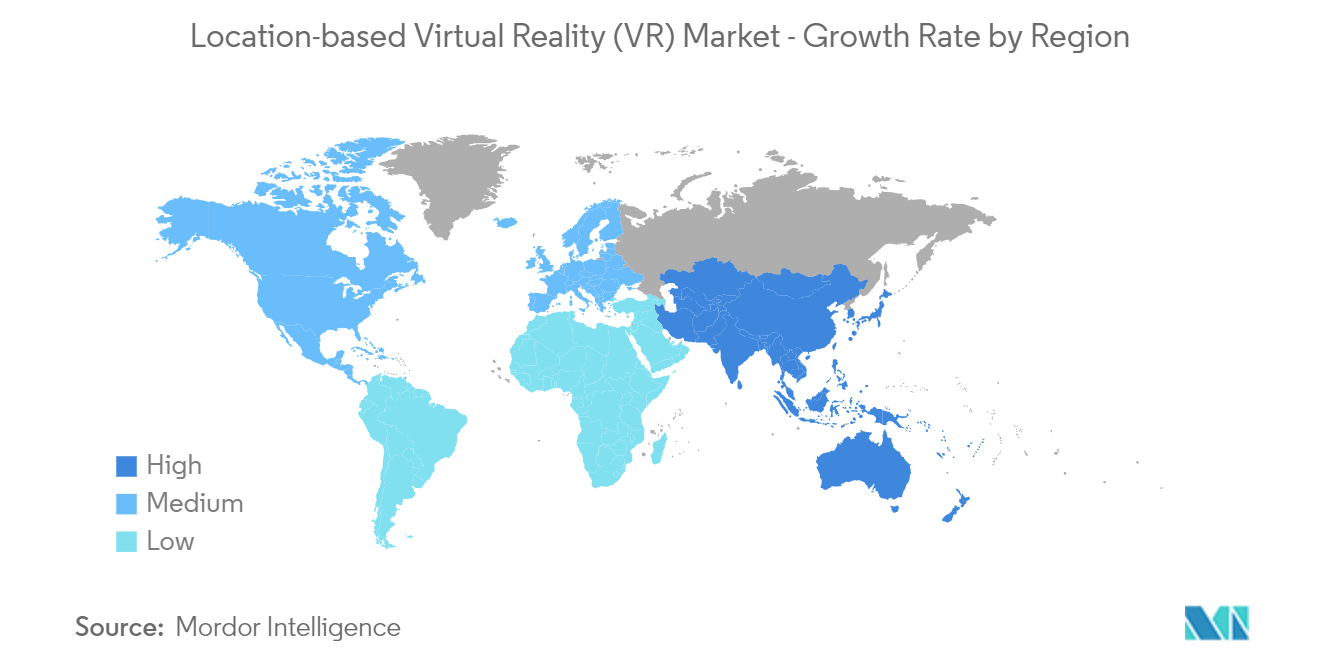
Location-Based VR Industry Overview
The location-based VR Market is moderately competitive with many regional and global players. With increasing technological innovations, the significant players in the market are focusing on expanding their customer base across foreign countries by leveraging strategic collaboration and investment initiatives to increase their market share and profitability.
- February 2024: Vertigo Games launched an optimized operator and user experience with ‘After the Fall: Arcade Edition’ with its SpringboardVR platform. This new arcade edition can create parties and competitions between and within arcade premises, which shows the demand for VR arcade games in the market, creating a growth opportunity for market vendors.
- August 2023: Hologate GmbH, a provider of Location-based VR solutions, secured EUR 8.3 million (~USD 9.19 million) in funding to increase the company's growth across entertainment and enterprise divisions, which is expected to support the company's objective to bring its simulation solutions to the global market, with a focus on Europe and North America, and support its growth in the location-based VR market.
Location-Based VR Market Leaders
-
EXIT VR
-
Springboard VR (Vertigo Games)
-
Zero Latency Pty. Ltd.
-
Survios, Inc.
-
Tyffon Inc.
*Disclaimer: Major Players sorted in no particular order
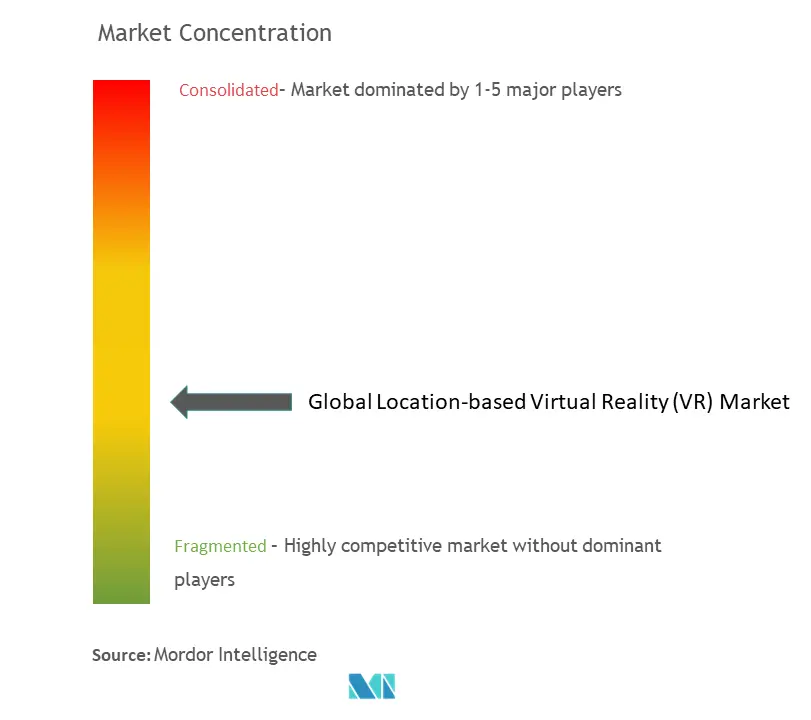
Location-Based VR Market News
- April 2024: xydrobe, an exclusive VR destination, announced Harrods, a British luxury department store, as the first retail partner to open its advanced multi-sensory virtual reality cinema, providing visitors access to a diverse program of immersive experiences from the world’s most coveted luxury brands. The xydrobe VR Cinema was planned to be opened in June 2024 on the fifth floor of the Knightsbridge landmark, providing customers with an immersive 4D experience that aims to redefine the essence of storytelling and entertainment, which shows the future growth potential of the location-based VR market.
- August 2023: Sandbox VR, a provider of location-based virtual reality (LBVR) experiences, announced significant growth and sales milestones and reported that its Deadwood Valley, LBVR studio, has registered USD 23 million in ticket sales since the beginning and is projected to make USD 100 million in lifetime sales, which shows the increasing demand for LBVR market in the gaming and entertainment sector.
Location-Based Virtual Reality Market Report - Table of Contents
1. INTRODUCTION
1.1 Study Deliverables and Market Definitions
1.2 Scope of the Study
2. RESEARCH METHODOLOGY
3. EXECUTIVE SUMMARY
4. MARKET INSIGHTS
4.1 Market Overview
4.2 Industry Attractiveness - Porter's Five Forces Analysis
4.2.1 Bargaining Power of Suppliers
4.2.2 Bargaining Power of Buyers
4.2.3 Threat of New Entrants
4.2.4 Threat of Substitute Products
4.2.5 Intensity of Competitive Rivalry
4.3 Impact of COVID-19 on the Market
5. MARKET DYNAMICS
5.1 Market Drivers
5.1.1 Increasing Implementation for Arcade-based VR Solutions
5.1.2 Increasing Popularity of 360-Degree Content
5.2 Market Restraints
5.2.1 High Cost of VR Content Development
6. MARKET SEGMENTATION
6.1 By Type
6.1.1 Hardware
6.1.1.1 Head Mounted Display
6.1.1.2 Head-up Displays
6.1.1.3 Glasses
6.1.1.4 Sensor
6.1.1.5 Camera
6.1.2 Software
6.2 By Application
6.2.1 VR Arcades
6.2.2 VR Theme Parks
6.2.3 VR Cinemas
6.3 By Geography
6.3.1 North America
6.3.2 Europe
6.3.3 Asia-Pacific
6.3.4 Rest of the World
7. COMPETITIVE LANDSCAPE
7.1 Company Profiles
7.1.1 EXIT VR
7.1.2 Springboard VR (Vertigo Games)
7.1.3 SpaceVR Inc.
7.1.4 Survios Inc.
7.1.5 Hologate GmbH
7.1.6 Zero Latency PTY Ltd
7.1.7 Oculus VR LLC (Facebook Inc.)
7.1.8 HTC Vine (HTC Corporation)
7.1.9 Tyffon Inc.
7.1.10 Neurogaming Ltd
- *List Not Exhaustive
8. INVESTMENT ANALYSIS
9. FUTURE OF THE MARKET
Location-Based Virtual Reality Industry Overview
A location-based virtual reality (LBVR) system is a collection of hardware and software components that allows users to perceive and experience a virtual environment in real time. Virtual reality refers to the hardware and software required to create and interact with a virtual environment for a real or fictional subject.
The location-based virtual reality (LBVR) market is segmented by type (hardware and software), application (VR arcades, VR theme parks, and VR cinemas), and geography (North America, Europe, Asia-Pacific, and Rest of the World). The market sizes and forecasts are provided in terms of value (USD) for all the above segments.
| By Type | |||||||
| |||||||
| Software |
| By Application | |
| VR Arcades | |
| VR Theme Parks | |
| VR Cinemas |
| By Geography | |
| North America | |
| Europe | |
| Asia-Pacific | |
| Rest of the World |
Location-Based Virtual Reality Market Research FAQs
How big is the Location-Based VR Market?
The Location-Based VR Market size is expected to reach USD 1.58 billion in 2024 and grow at a CAGR of 32.80% to reach USD 8.73 billion by 2029.
What is the current Location-Based VR Market size?
In 2024, the Location-Based VR Market size is expected to reach USD 1.58 billion.
Who are the key players in Location-Based VR Market?
EXIT VR, Springboard VR (Vertigo Games), Zero Latency Pty. Ltd., Survios, Inc. and Tyffon Inc. are the major companies operating in the Location-Based VR Market.
Which is the fastest growing region in Location-Based VR Market?
Asia-Pacific is estimated to grow at the highest CAGR over the forecast period (2024-2029).
Which region has the biggest share in Location-Based VR Market?
In 2024, the North America accounts for the largest market share in Location-Based VR Market.
What years does this Location-Based VR Market cover, and what was the market size in 2023?
In 2023, the Location-Based VR Market size was estimated at USD 1.06 billion. The report covers the Location-Based VR Market historical market size for years: 2019, 2020, 2021, 2022 and 2023. The report also forecasts the Location-Based VR Market size for years: 2024, 2025, 2026, 2027, 2028 and 2029.
Location Based VR Industry Report
Statistics for the 2024 Location-Based VR market share, size and revenue growth rate, created by Mordor Intelligence™ Industry Reports. Location-Based VR analysis includes a market forecast outlook to for 2024 to 2029 and historical overview. Get a sample of this industry analysis as a free report PDF download.

